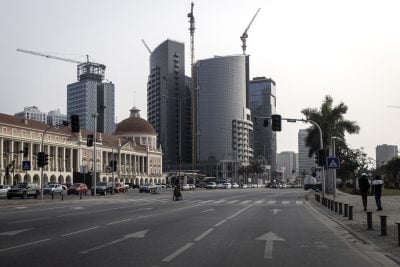In late March, an intense tropical cyclone hit Southern Africa, wreaking destruction across Mozambique, Zimbabwe and Malawi. Tendai Marima assesses the damage and talks to local inhabitants affected by the storm.
Destroyed buildings, fallen electricity pylons and broken roads scar the landscape in the parts of Mozambique, Malawi and Zimbabwe ravaged by Cyclone Idai.
The three countries face a task of recovery and reconstruction that could take years, according to international aid and local country officials.
Described as the worst natural disaster to hit southern Africa in decades, Idai has left nearly 1,000 people dead, hundreds still unaccounted for and more than 100,0000 houses destroyed, according to UN estimates.
The torrential storm, which made landfall in March, hitting Mozambique, southern Malawi and Zimbabwe’s eastern highlands, has left more than 3m people in need of aid.
According to Vera Songwe, executive secretary of the UN Economic Commission for Africa, Idai’s impact on southern Africa has been massive.
“We probably have lost about a billion dollars in Mozambique, Zimbabwe, Madagascar and Malawi in terms of resources,” she told delegates at a conference in late March.
Beira, a trading city in the central region of Mozambique, suffered the first shocks. According to the Red Cross, 90% of the city was damaged or destroyed.
In Beira Port, a regional gateway into southern and east Africa, warehouse roofs were blown away.
While repairs are underway, the bulk of the storerooms are still out of use as extensive restoration is required.
Some areas of the city are still without electricity and potable water, which has resulted in a severe cholera outbreak affecting thousands of displaced residents.
Along the beachfront, small shops are still in need of repairs and in the outlying suburb of Ndunda, some residents have been made homeless.
Pedro Vilanculos, 51, had to build a shack to shelter his family of six and with his regular job lost to the storm, he now works as porter, carrying goods on foot for over 6km.
“I had to rebuild for my family, there is no way we could live under a tree without anything and without money.
“I carry things for people who cannot walk from the city centre. It’s not easy, but I have to earn something for my family,” he tells African Business.
Outside Beira, the cyclone damage is still visible. In central Mozambique, small towns and villages in the Sofala, Manica and Zambezia provinces that were submerged in water have suffered extensive damage.

Assessments of the damage to the sugar mills in Sofala, the hardest-hit province, are still ongoing, while damage to electricity supplies, public buildings and public markets is still being collated.
Major roads connecting Mozambique to neighbouring Zimbabwe and Malawi have been severely impacted and are only partially in use, causing long delays in the movement of goods.
Over 500,000 hectares of crops have been destroyed just before harvest season, leading the UN’s World Food Programme to raise Mozambique’s food security classification to the same level as that of war-torn Syria.
Food crisis in Zimbabwe
In Zimbabwe the death toll from the cyclone stands at 344. In February, even before the cyclone hit, the World Food Programme had estimated that 5.3m people were in urgent need of assistance due to an El Niño-induced drought and the country’s economic problems.
In early April, the country applied for $613m in aid to help cover the costs of food imports and humanitarian assistance in the wake of Idai, which damaged the maize fields of the eastern highlands.
Subsistence farmers have been badly hit, but commercial farms have suffered significantly too.
Tyrone Puckett, owner of Rathmore Estate, a vast plantation in Zimbabwe’s eastern Chimanimani district that produces timber, avocados and macadamia nuts for export, is concerned about how he will recover from the losses to his farm.
Chimanimani was inaccessible by road for a week following the heavy storms and Rathmore was isolated for nearly two weeks due to damaged roads.

“The roads to the farm are in bad shape. We’ve had to use rocks to cover the huge holes in the ground and now I’ve got to think about the farm itself.
There’s an assumption from the government that commercial farmers can take these losses, but I can’t, this farm isn’t what it used to be,” he tells African Business.
Puckett is one of a few hundred white commercial farmers remaining in Zimbabwe.
Many of them operate in the east of the country and its Midlands province, but since the fast-track land reform programme in the 2000s, which saw the state-sanctioned seizure of white-owned farms, Zimbabwe’s food production has suffered a significant blow.
The agro-based economy is still struggling to recover and factors such as drought, a severe ongoing liquidity crisis and now the cyclone could significantly set it back.
Economist John Robertson says that while assessments of the losses are still ongoing, the cyclone would have a significant impact on the economy:
“It’s hard to say what the figure could be at this stage, but it could run into millions when you consider losses in export revenue for farmers and the damage to road infrastructure, electricity lines and the impact on the country’s fuel supply feed from Beira.”
Zimbabwe receives the bulk of its fuel supplies from South Africa and Mozambique via the Beira pipeline.
Dialogue over the construction of a second pipeline between Mozambique and Zimbabwe could be placed on hold as both countries recover from Idai.
Energy supplies disrupted
Other countries in the region are likely to feel the effects of Idai on their energy consumption for some time to come.
South Africa, which imports roughly 1,000 MW of electricity daily from Mozambique’s Cahora Bassa hydroelectric power plant, experienced severe electricity shortages when the cyclone hit.
The country is already experiencing problems with its power supplies, and as Mozambique battles to recover from the storm and the region heads towards the cold season, when power usage increases, it may find itself plunged into darkness for longer hours.
In Malawi, where nearly a million people have been affected by the heavy rains, fewer lives were lost due to disaster preparedness.
However, food prices have soared by at least 20% and there is considerable infrastructural damage to roads and school in the southern Makhanga district.

Although all areas on the banks of the southern Shire River are now accessible, in April the Malawian government launched an international appeal for $43m to assist people living in cyclone-affected areas who need long-term support in food, water, shelter, and sanitation.
Thus far the African Union has released $100,000 in support to Malawi and a further $150,000 each to Mozambique and Zimbabwe.
In addition, the African Development Bank (AfDB) has pledged $100m towards reconstruction of affected areas in Mozambique, Zimbabwe and Malawi.
In April, the World Bank convened a donor conference in Washington to raise funds for long-term humanitarian support particularly for Mozambique, where over 1.85m people are in need of emergency aid.
The International Monetary Fund, which is still assessing the costs of damage to Mozambique, has said the costs of reconstruction will be “significant” and is considering an emergency assistance package for Mozambique under its Rapid Credit Facility.
Improving disaster preparedness
While drumming up financial support is key for reconstruction and recovery, Southern Africa still remains susceptible to cyclones.
In a world with a rapidly changing climate, disaster preparedness is key to reducing the financial and infrastructural losses in vulnerable countries.
The UN Environment Programme (UNEP) has said the widespread impact of Cyclone Idai highlights the need for African countries to develop better disaster preparedness and management systems.
“The cyclone is yet another reminder of the need for more and urgent investment in ecosystem disaster risk reduction and climate change adaption to reduce the human and financial toll of natural disasters,” said Juliette Biao, UNEP’s regional director for Africa, in a statement in April.
“Sound environmental management and climate change impacts and disaster responses are closely interlinked and require a more systematic and comprehensive approach to disaster risk management.”
Recovery may take years
As Mozambique’s fragile economy recovers from a two-year economic slump, the country now has to recoup from the losses of the cyclone.
South Africa’s Standard Bank anticipates inflation will rise and has revised the country’s growth forecasts downwards from 3.7% to 3.5%.
Across the border in Zimbabwe, the hurricane compounds an already difficult situation for a country facing fuel, money and food shortages.
It may be some time before the cash-strapped government is able to meet the recovery needs.
While Malawi, with 69 deaths, may have suffered the least loss of human life, the financial losses could be hard to cover as the country has a widening fiscal deficit, which according to World Bank statistics, rose from 4.8% to 7.3% of GDP in the 2017/2018 financial year.
The challenges facing southern Africa’s countries are multi-dimensional and it could take years to get over the devastation caused by Idai.
Want to continue reading? Subscribe today.
You've read all your free articles for this month! Subscribe now to enjoy full access to our content.
Digital Monthly
£8.00 / month
Receive full unlimited access to our articles, opinions, podcasts and more.
Digital Yearly
£70.00 / year
Our best value offer - save £26 and gain access to all of our digital content for an entire year!
 Sign in with Google
Sign in with Google 


